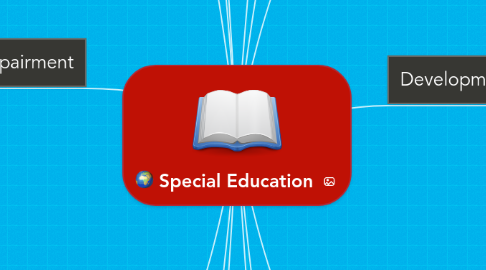
1. Specific Learning Disability
1.1. intervention/modifications
1.1.1. Listening to good stories and books, appropriate to the child’s age, read aloud daily
1.1.2. Listen to audio recordings and learn content from audiobooks, movies, videos and digital media instead of reading print versions
2. Other Health Impairment
2.1. intervention/modifications
2.1.1. Peer (classmate) note taker
2.1.2. More easily readable visual aids
2.1.3. Screen access to tests administered on a computer
3. Intellectual Disability
3.1. intervention/modifications
3.1.1. Adapt materials to the needs of students, by reducing reading, writing, and language requirements and simplifying work sheets.
3.1.2. Adapt instruction by employing clear, organized presentations, providing concrete, meaningful examples and activities, providing frequent reviews, and encouraging independent thinking.
3.1.3. Communicate with families to further your understanding and obtain additional information on how students work best. The Diversity in the Classroom feature describes a model of “Person-Centered Planning” for working with Asian American families.
4. Hearing Impairment
4.1. intervention/modifications
4.1.1. Use of visual supplements (projected materials, whiteboard, charts, vocabulary lists, lecture outlines)
4.1.2. Personal hearing device (hearing aid, cochlear implant, tactile device)
4.1.3. Captioning or scripts for announcements, television, videos, or movies
4.1.4. Check for understanding of information, down time / break from listening, extra time to complete assignments, and step-by-step directions
5. Emotional Disturbance
5.1. intervention/modifications
5.1.1. Role-playing situations
5.1.2. Seating arrangement to encourage social interaction
5.1.3. Personalized goals and strategies, so that the child can find success
6. Traumatic Brain Damage
6.1. intervention/modifications
6.1.1. Allow student to audio record lectures for later playback; provide both oral and written instructions; clarify instructions
6.1.2. Avoid placing student in high pressure situations
6.1.3. Case Study: Brain damage. We have an 18 year old student who is severely handicapped mentally as her brain never fully developed. She is unable to read or write and mentally functions at the educational level of a 3rd grader. However, she is capable of communicating orally but does have a speech impediment. All of her homework, quizzes, and tests are conducted orally.
7. Deafness
7.1. intervention/modifications
7.1.1. Reduce noise and reverberation with carpeting, draperies, acoustic ceiling tile, and/or acoustical wall treatments. Use flashing lights along with bells for signaling class schedule.
7.1.2. Team teach with a teacher of students who are deaf or hard of hearing.
7.1.3. Demonstrate directions to clarify what needs to be undertaken.
8. Autism
8.1. intervention/modifications
8.1.1. Case Study: Autism. We have a 3rd grade student who has been diagnosed with mild to moderate autism. His classroom modifications are him in a smaller classroom environment where he is more comfortable. He is allowed to have extra grade opportunities (redo if items missing). Repeat directions verbatim. Modify test formats (word bank, multiple choice). He is also allowed to tape record the lessons so he can review them at home in a more comfortable setting.
8.1.2. Have a set routine for the school day. For younger students, provide a picture schedule. The schedule can be posted for all students to use or a small, desktop version can be created.
8.1.3. Incorporate pictures, images and other visual aids when teaching vocabulary words, scientific subjects and abstract concepts.
8.1.4. Allow extra time for completing tests and in school assignments.
9. Deaf-Blindness
9.1. intervention/modifications
9.1.1. Braille writing and reading
10. Visual Impairment Including Blindness
10.1. intervention/modifications
10.1.1. Braille
10.1.2. Case Study: Visual Impairment/Blindness. A 1st grade student of ours is considered legally blind by Italy’s standard definition; however, she still has limited sight. She is given preferential seating and is paired with another classmate. Pairing the student allows her to obtain additional help if the words are not viewed. Often she has is a magnifying glass on hand which assists her in classroom reading.
11. Developmental Delay
11.1. intervention/modifications
11.1.1. Realize their educational goals
11.1.2. Encourage that behavior is to be consistent with classroom
11.1.3. Doing the same thing everyday the student knows what to expect and can begin following the same actions without additional guidance.
12. Speech or Language Impairment
12.1. intervention/modifications
12.1.1. Provide the student with a talking ha nd held dictionary or spelling aid to assist in identifying unknown words
12.1.2. Summarize information in language appropriate to the student’s linguistic capabilities
12.1.3. Provide peer or adult assistance with unfamiliar words and concepts
13. Orthopedic Impairment
13.1. intervention/modifications
13.1.1. Securing assistive technology and augmentative communication devices.
13.1.2. Instruction focused on impairments in and the improvement of gross and fine motor skills.
13.1.3. Extended time to complete assignments.
14. Multiple Disabilities
14.1. intervention/modifications
14.1.1. Breaking up testing over several days
14.1.2. Providing audiotaped lectures or book
14.1.3. Reducing the reading level
14.1.4. Working one-on-one with the teacher
